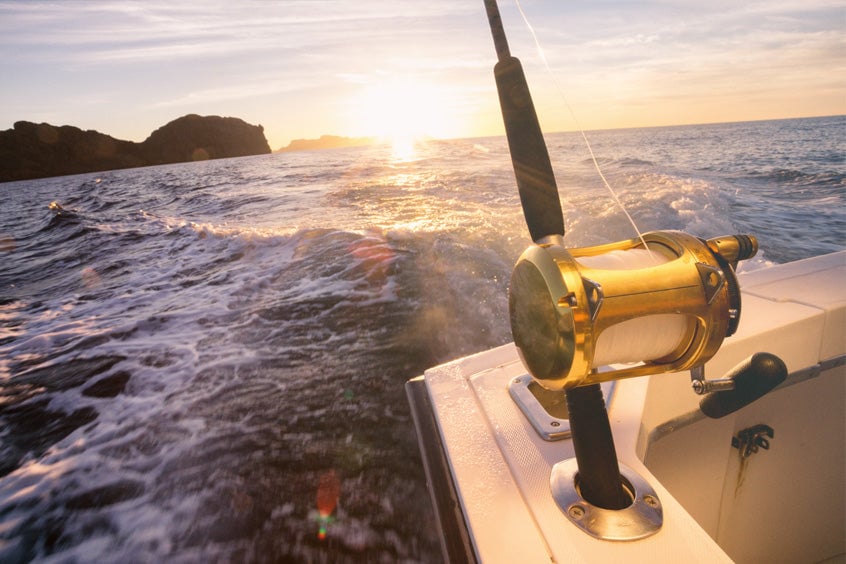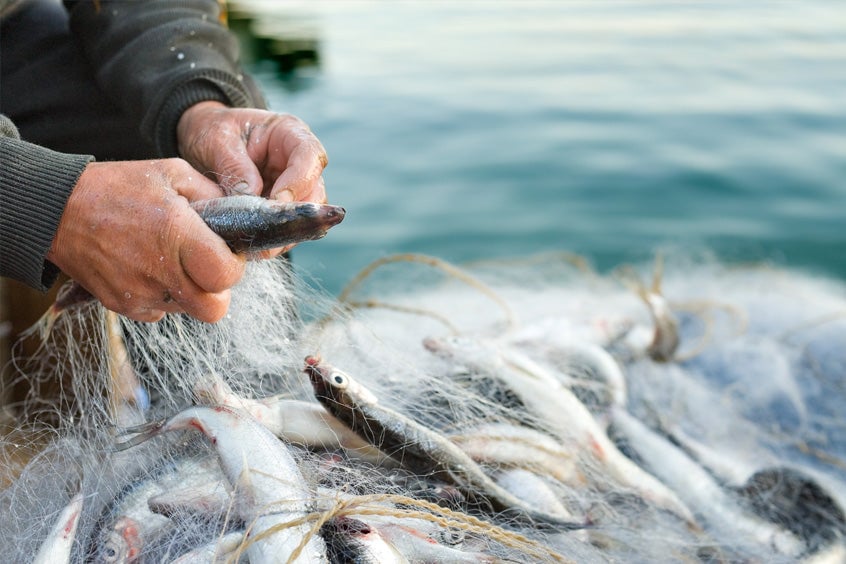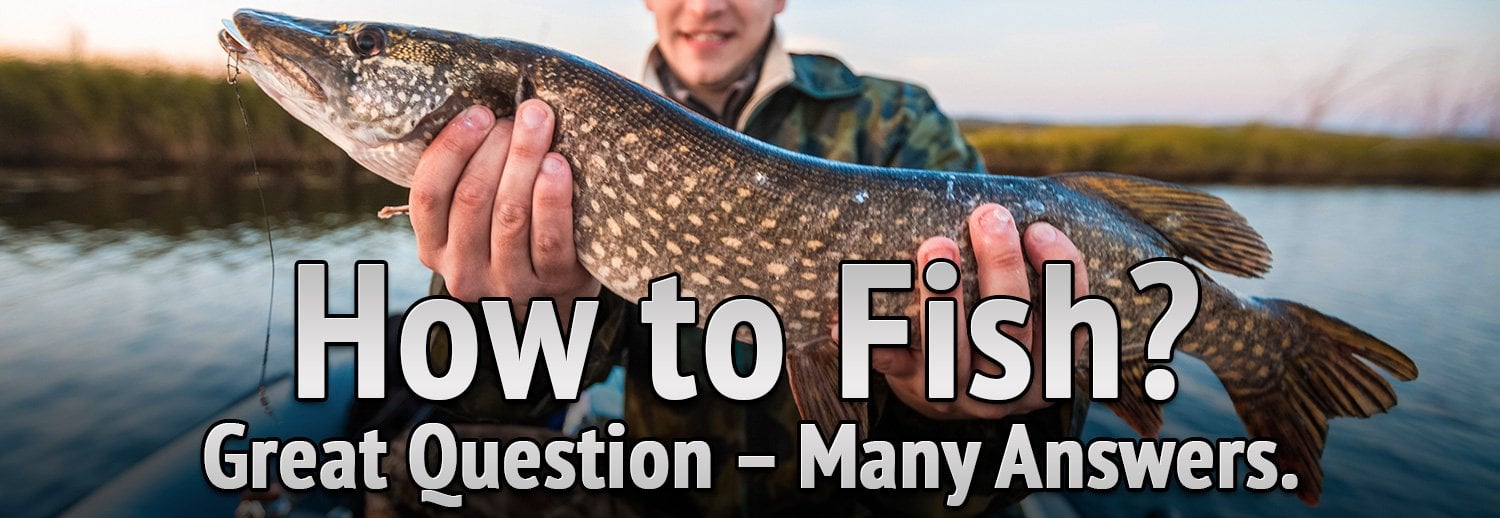
Part 2: Tactics and Techniques
In our first installment on survival fishing, we covered the basics. We briefly discussed:
- The benefits of learning the skill of fishing
- How to get started in learning
- Tactics and techniques
- Types of fish
Today, we’ll expand our discussion of tactics, techniques and gear to be more comprehensive.
One quick note before we begin: in our first installment, some astute readers pointed out that some of my advice might not work in a survival situation. The purpose of this series is to help people practice and learn the skill of fishing so they can then apply that knowledge to a survival situation. Wherever possible, I will note possible distinctions that may arise in a crisis. I will also make this the focus of a later installment, to cover these bases in-depth. I thank our readers for pointing this out – your feedback is always helpful and encouraged!

Rod & Reel Fishing
One of the most ubiquitous images of fishing in our culture is with a rod and reel. It is also called “angling” because of the angle the line forms from the tip of the rod to the fish when hooked up. However, some forms of angling, like cane pole fishing, don’t use reels and are still considered angling.
There are many kinds and styles of rod and reels available. Fishing rods and poles can range from just a couple feet to 15 feet long. Reels come in different designs, including spinning, casting and fly reels. All of this variety can be overwhelming and confusing.
In a moment, I will briefly break down the most popular rod and reel combinations and how they’re used.
I highly suggest you seek out local and regional advice on which angling styles are best for where you live so you can practice.
With that, it’s important to note that rod and reel fishing takes the most time, energy and equipment investment, both to learn and practice. Being effective with a rod and reel in a survival situation is great, but oftentimes it’s the least ideal option. Other tactics that don’t require that much equipment, casting and searching for fish are often a much better choice in a survival situation.
Here is the brief overview of angling styles I promised.

Spin Fishing
Spin fishing is named for the use of spinning lures. But the spinning reel, also known as the fixed spool reel, has come to be associated with this style of fishing as well.
This is one of the most commonly used styles of rod and reel, and is one of the most easy to use. An even easier-to-use innovation, the spincast reel, colloquially known as Zebco reels are even easier to learn on. Both are easier to use because they are not complicated and therefore tangle and “screw up” a whole lot less.
I’d recommend you’d start here with a light-to-medium 6-8 foot rod. A note: the “lightness” or “heaviness” of the rod determines the weight of the lure or bait you can throw on the rod. Lighter rods tend to be more flexible and more sensitive to bites, especially when using light line (more on line in a moment).

Casting
Baitcasting, or casting rod and reel combos, are also very popular, especially amongst bass anglers.
These combos have a reel on top of the rod, and require a different casting motion and technique. The reels themselves are not very forgiving for beginners, and are prone to tangles.
These kinds of rods also are preferred for big game and surf fishing, a high-risk, high-reward activity. If you are skilled enough for this kind of fishing, it could be invaluable in a crisis, as one fish could feed many. It’s something to work up to as a beginner.

Fly
Fly fishing rods and reels differ from the above types of fishing gear in a few ways.
The first is that fly-fishermen do not use bait. They use “flies” or lures, usually small to very small, that imitate the prey that fish eat. Since you are using a very small lure, it would be very difficult to cast on just a thin line. So fly rods use special lines that have heft to them to help you propel it to the target. This line also requires that you use a different casting technique, swinging the line like a pendulum back and forth before releasing it toward the target.
There are no rules that say you can’t use a simple baited hook with a fly rod and reel. All bets are off in a survival scenario especially. However, working your way up to fly fishing could also come in handy in a survival situation, especially if you live near small streams with wild populations of fish. Many folks who practice self-reliance also use their chicken or turkey feathers to create their own lures, called fly tying. The hair of game animals is also often used in tying flies.
That covers the three main types of rod and reel fishing. Of course, you can simplify this in a survival scenario. You can easily create your own “cane pole” out of a long piece of green wood. Select a branch on a live tree 7-12 feet long that’s slightly thinner than your wrist at the base and about the thickness of your thumb at the tip. Cut a notch at the top of the tip for the line. Knot your line in the notch. A thin length of twine about half the length of the rod, attached to thinner fishing line or dental floss, then attached to a baited hook and you’re ready to fish. Instead of reeling them in, you have to raise the rod tip and “walk” the fish ashore or into the net.
Now we move on from rod and reel fishing to some of my favorite survival fishing tactics…Before we do, I want to quickly note that some of the below methods may be restricted or regulated by wildlife authorities in your area. Check with them before practicing any of these methods.

Handlining
Handlining is probably the oldest, simplest and easiest to understand styles of fishing.
In some parts of the world that do not have as much access to fishing equipment, this is still the most popular way.
Handlining is a method where you use one line attached to a baited hook or lure with a weight (maybe a bobber or float).
You cast, set the hook, and reel in the fish with your two hands. Some use wheels or dowels to spool line and reel it in – an improvement – but still very simple.
If you’ve ever seen the movie Jeremiah Johnson or read Hemingway’s The Old Man and the Sea, you’ve seen handlining in action.
You can handline from a bank or shoreline or do it from a boat.
Toss it out and let it sit. Wait for a bite, which will feel like anything from small vibrations and taps on the line, to a full-on tug. At any indication of this, you typically set the hook by giving your end a short, firm tug. However, if you’re after something like crabs, they may just be holding on to your bait and not actually hooked, so a slow retrieve is called for.
Handlining is a good method in a survival situation because almost anyone can do it and figure it out. If you cannot expend much energy, handlining can be effective, but your catch rate will increase with a bit more activity (casting more, “reeling” in to entice strikes, etc.)
One note of caution: hooking a big fish while handlining can be dangerous. If you are fishing water where this is possible, make sure you have line coiled to play the fish and let it run. If you are too tight to a large fish and are playing it by hand, the fishing line could cut through or significantly burn your hands. No fish is worth injury or death – especially when you’re already struggling to survive.

Line Setting
Setting lines is a technique with a lot of variations. Longlining, or droplining is the type of fishing they do for swordfish and marlin. Hundreds of cabled line with shorter leaders and baited hooks attached, off the back of a boat. You may have seen it in the movie A Perfect Storm.
Basically, a set line is a fishing line set in the water. It’s the most “set it and forget” it method, equaled only by trapping. I highly recommend you learn these methods of fishing for survival purposes.
Trotlines are one popular way of catching fish and also crabs. A line is spread across a piece of water by two vertical posts, either trees or something the fisherman sets up themselves. Attached to this line are the leaders and baited hooks that go into the water and attract the fish. Every so often, the fisher checks the set hooks, removes any fish caught, rebaits if necessary, and its ready to catch more fish.
Another cool way of set line fishing, especially on still water like lakes and ponds, is with something called a jug. Basically, you tie a line to a buoy (or an empty 2-liter soda bottle) and bait a hook. You can watch these jugs in the water, and if they bob under or go from laying sideways in the water to straight up and down, you know you have a fish on.
Please note that in some areas this type of fishing is highly regulated or restricted. Many other fishers frown upon it (because it is highly effective). In a survival situation, it can’t be beat. You set a line and go do something else. You rest. You make fire. You administer first-aid. Then you can come back and have dinner.

Trapping
Trapping, as I mentioned before, is another low-energy way of catching fish, shellfish and historically, freshwater eels.
To pull this off, you either need a trap or need to build one. Traps can be elaborate woven baskets. Or they can be built from the rocks and sticks and logs around the body of water you’re trying to trap in.
Building a trap (high energy demand) in a survival scenario should be a low priority, but it can be a great way to sustain food if the initial crisis blows over and civilization begins to rebuild.
If I were to add trapping to my fishing survival skills, I would buy a few that would work in my area and keep them with the rest of my survival gear. If you want, you can also store some instructions for building your own traps.

Netting
Netting has a lot of variation too. Some nets are stationary and work like traps, as in gill nets. Dip nets and casting nets, on the other hand, require that the fisher do the work. Locate the fish and bring the net to them without scaring them off. Not an easy proposition, even with tiny, dumb baitfish.
Netting is also highly regulated, so it won’t be easy to practice, at least when trying for game fish. But it can be great practice for catching bait, to be used on any of the other tactics that require it.
The techniques for using nets range from simple to complex. It would not be my first choice in a crisis.

Spearfishing & Bowfishing
The last two types of fishing I’ll mention seem to be very popular in some survivalist circles. I think it might have to do with the fact that fishing successfully this way makes one look pretty cool.
Spearfishing uses a spear, as its name implies. There are many ways to utilize this primitive tool today. Spearguns are often used by divers, who get up close to their prey and shoot them. The spear is attached to a cable they pull them in on.
Some spears are meant for use above the water, as in a gig. Gigs have been popular to take all kinds of fish and animals, including flounder and frogs. Bowfishing uses a bow and arrow. Many modern fishers re-purpose an old compound bow for this purpose, even fashioning rudimentary reels onto them.
Both spearfishing and bowfishing would be great to learn, especially if they’re popular in your area. However, friends I talk to who fish this way often say that being able to find where the fish are concentrated is critical. With a rod and reel or any of the other methods listed above, it’s easy to find a fish once in a while. But if you are spearfishing or bowfishing and you only see a fish every once in a while, you’re wasting your time. This is why I would not recommend this as a priority for learning or employment in a survival scenario.
Phew. That’s a lot of techniques. And of course, I’m sure I left out some good ones. Be sure to let us know if you think we’re overlooking a good technique for survival fishing.
In summary, I think for survival fishing, the simpler the better. A handline, a few set lines and traps, and a cane pole could be your ticket to survival in a crisis. Mastering all of these would be great, but you can only do so much. I hope I’ve helped you assess how you might expand your current skill and knowledge base.
So now that we know many of the ways how to fish, next time we can discuss catching, keeping, cleaning and preparing fish for eating.
Until then, stay alert, and start practicing your fishing skills!
In Liberty,
Grant Miller
Preparedness Advisor, My Patriot Supply
P.S. To learn more about self-reliance, follow MPS on Facebook or Twitter.


